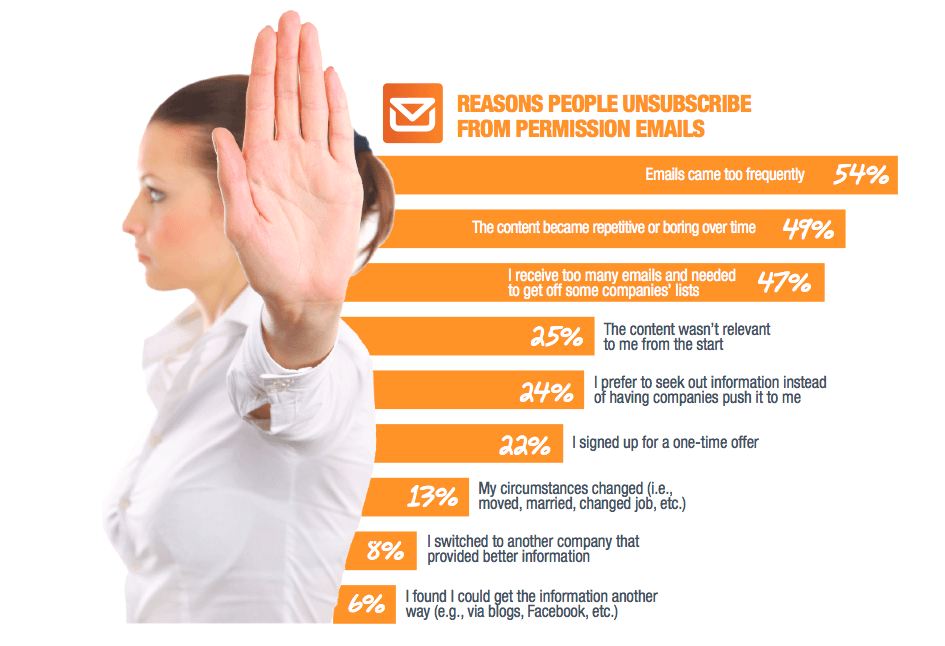I’ve witnessed an unfortunate trend over the past several months involving more email senders making unsubscribing a challenging experience for recipients. I’ve been in the email industry for over six years and have seen both the best and worst practices from a variety of email senders. I’ll share my perspective on why you should improve your unsubscribe experience.
Why do people unsubscribe from email campaigns?
This might be common sense to most, but the top reasons why people unsubscribe from email campaigns. In a 2011 study from ExactTarget, email frequency from a sender, content relevance and overall inbox volume topped the list of reasons why people unsubscribe. In other words, the sender was no longer delivering value to their recipients. Period. If an email is truly valuable, it will be opened, read and possibly clicked if it is reasonably beneficial.
When someone unsubscribes from your email, why would you want to make that experience frustrating? Some email providers make it painful to unsubscribe. So painful, it compels them not to subscribe again.
An unsubscribe doesn’t mean “never,” it means “not now.” I’ve been known to subscribe again to trustworthy senders well after I previously unsubscribed. Why? They offered something of value and re-engaged me. If it’s a brand or source I enjoy, I’ll continue to follow them on social media.
But, what about my email list? I need to make sales!
First off, it’s not “your list,” they are permission-based invites to someone’s inbox. Permission fades as you don’t live up to your commitment as a sender. Letting someone off your list is a healthy and expected stage of the customer lifecycle. Perhaps your emails were boring, or maybe they changed their email address? Maybe they simply are no longer interested in your products or services.
Second, if a person is even remotely close to unsubscribing, they are very far from desiring to buy your products or services. They are dead weight. Sending them repeated messages is not going to get them any closer to becoming a customer.
Third, you should be segmenting your email list among those who have demonstrated a modicum of interest in your content. Repeatedly sending email to those who don’t open or click is not going to magically result in an overnight sale. Segmentation and laser-targeting smaller email sends is critical to achieving higher response rates with fewer unsubscribes.
Fourth, list attrition won’t be avoided by making the unsubscribe experience challenging for people. It will only be magnified. If a user cannot easily express their intent to unsubscribe, they will escalate their action to a spam complaint. Reaching their inbox is a privilege, not a right, among email senders.
… Okay, so I think I’ve made the case for why you should make unsubscribing easy.
Offering recipients to unsubscribe actually minimizes list attrition.
This isn’t only my opinion. I have a practical example that shows that people enjoy being presented the right to easily unsubscribe.
Some time ago when I ran our company’s customer newsletter, I decided to try an experiment. Simply, I encouraged subscribers to unsubscribe – boldly and conspicuously. At the time, the list was about 5000 people. Normally we’d experience about 5-10 unsubscribes from customers. Yikes. When I sent the email with my encouraging pre-header to have them unsubscribe – zero people opted out.
My experience suggests that when people feel reassured that you’re giving them an out, they won’t take it. Conversely, when an email campaign feels inescapable, they will hunt for the way out and exercise their right accordingly.
Stop using deceptive tactics to make unsubscribes difficult!
These dark patterns exist for no other reason than to mislead the recipient:
- Requiring the recipient to type in their email address (again) to unsubscribe. The theory behind this tactic is that if an email is forwarded, the secondary recipient might unknowingly unsubscribe the original recipient. This fear is unfounded. I doubt it happens to the extent that requires people to double-confirm their opt-out request. This is a manufactured concern. I’ve yet to be convinced of the reality of this ‘threat’ to an email list.
- Providing numerous email lists to for a recipient check or un-check manually. This irritates me for two reasons. First, the recipient has to parse out the action they must do to remove themselves. The default action is to un-check all the options – then at the very bottom, the recipient discovers the ‘Unsubscribe from All’ option. This affirms that the sender completely wasted the recipient’s time. Second, it shows how many lists the sender actually placed them on – and sometimes it’s not pretty. If you do this, stick to fewer than five ‘lists.’ Keep it simple, please.
- Using deceptive language. By far, this is the most bothersome because it demonstrates the ethos of the sender. An example of this is language like, “Are you sure you don’t want to unsubscribe? [Yes] [No]” If it requires someone to re-read your confirmation message, you’ve failed. The recipient already clicked a link to unsubscribe; why make them further declare their intent and lose any remaining trust they have in your brand? For these shady senders, I block their domain and report spam to further penalize them.
- Failing to (completely) honor an unsubscribe request. Some senders interpret an unsubscribe request to mean the category of emails that I’m subscribed to. That is, if I unsubscribe from their blog, I somehow must still be interested in their prospect emails. When this happens, I instantly block their domain from reaching me. They violated my trust and likely violated the CAN-SPAM Act.
The burden of responsibility to make unsubscribes easy and user-friendly is shared among email service providers and senders. With restrictive policies, it forces senders to take subversive action to bypass unsubscribe processes. With too much flexibility, senders shoot themselves in the foot unknowingly. Educating senders on how to properly handle unsubscribes is critical to minimizing dissent and abusive reactions from senders.
If you’re an email sender, I encourage you to make the unsubscribe link easy, inviting and friendly for me to click. I probably won’t unsubscribe, but if I do, please respect my request. It’s entirely possible that I follow you on Twitter or Like you on Facebook. Make those interactions count and encourage me to sign up again and let’s get started on the right foot.
A good way to make the unsubscribe not feel so transactional is to attach it to an emotional outcome. That is, apply your own self-deprecating humor to have fun with recipients and make your unsubscribe confirmation page at the very least, entertaining. Hey, if they wanted to unsubscribe, you might as well make them leave with a smile.
Together, we can keep email valuable for both people and businesses.
This post is a part of my 60 days of blogging. Read more about #60DOB.
Photo credit: CarbonNYC


